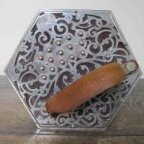Search the Community
Showing results for tags 'learning'.
-
Have just bought a copy of Gary Coover's Anglo concertina in the harmonic style to further my understating of chord playing- My concertina is a G/D and the book is written with a C/G in mind. Are there abc notation versions of the tunes as written in the book anywhere, to save me having to create my own abc files to transpose. Or am I missing a trick here?
-
I am very new to playing the concertina, and am having trouble with the right hand being too quiet when playing an accompanying chord on the left hand. The left hand notes always seem to overpower the right when played in unison. If there is already a conversation about this, I welcome the link. I am trying to figure out if it is a. Human error b. Flaw/damage in instrument c. Both a and b d. Normal. and what I can do to remedy it. Thanks!
- 7 replies
-
- learning
- anglo concertina
-
(and 6 more)
Tagged with:
-
I'm feeling really discouraged. I can't play tunes at a consistent level and am always crashing and burning at sessions, even when I can play the tunes at home. I know the answer to this problem is more practice, but I could use some encouragement. Anyone?
-
Teaching Anglo concertina lessons at home and on skype all over the globe has been a continuing pleasure. My students come to me for a variety of reasons and I try to figure out just what they need to get the most out of the customized lessons I offer. A recent example... Some friends of mine in the theater recommended me to Doug Shapiro. He asked me to teach him how to play a few concertina songs for a theater production, now in rehearsal. He described it as “an audience immersion Avant-Garde show” ... well alright! His theater company had bought him a pretty little vintage red East German Anglo 20 button box for $50 off ebay. Doug fondly named it “Tchotchke Rosie” but he had no idea how to play it. Doug is an actor and singer with a high school level of musical training. He sent me three guitar and vocal audio recordings of proposed original songs. I agreed to meet him for a lesson at my studio here in Brooklyn, New York, to help him join the band for his new show. I thought that this effort was unlikely to work out, given the limitations of a 20 button ebay instrument, but you never know. When I tried his “Tchotchke Rosie” I was in despair. So crude, so out of tune and a high D/A tuning to boot. I told him that it was unlikely this junk box concertina would work, but I would give it a try and started in playing along with the audio tracks on his red junker. Amazing! It sounded pretty good and the keys they were playing in made the D/A box actually easier than a C/G would ever be. I made him some paper arrangements on the spot and sent him home to practice. A few days later, Doug had done his homework and could plausibly play complex chords along with the recordings. He impressed his fellow thespians in rehearsal and they decided that Doug should sing and play solo for some additional intermission entertainment. His plan, he told me, was to sing a few well known Christmas songs... in Yiddish. Oy vay! Sounds strange, but that’s what they are into. Apparently, Doug has done this sort of thing before, though he’s not Jewish and does not speak Yiddish. Check out his performance of the country classic “Your Cheating Heart.” https://www.youtube.com/watch?v=kLkV_QO8fqE So now, I have had a few more lessons with Doug and he’s a natural concertina player. He knows how to deliver a song, and for him, the concertina just fits right in without effort. I’ve just made him charts for “Walking In a Winter Wonderland” and “Feliz Navidad.” I’m sure he will do fine, singing his Yiddish translations of these fine Christmas classics.
- 3 replies
-
- 3
-

-
- concertina
- songs
- (and 4 more)
-
Hi everyone, I'm brand new to the concertina and have been perusing these forums for the past couple days looking for advice. Wanting to learn a new instrument, I bought an old Anglo 20 button Scholer off ebay to try (20 button to start out, and Scholer b/c from the reading I did, for price range going vintage vs new/made in China seemed the way to go.) I got it a couple of days ago, and it seems in pretty good shape, all the buttons have clear sounds, definitely something I could practice on. But, here is my issue. Since everything else on the market is C/G, I mistakenly didn't notice this Scholer is not (which looking back seems common for German-made in that time period). It took me a day to realize oh no, it's not just terribly out of tune; it's in D/A. I've played classical piano and flute for years, so I'm proficient in reading sheet music, and to have the notes on the page not match the notes from the instrument is really messing with my head. So here are my questions, I guess: 1) Is it generally easier to learn on a C/G 20 button if you ever plan on moving up to a (presumably C/G) 30 button Anglo later? 2) Is it much more advantageous to have the C# available than regular ol' C? Should I keep it for that alone? If I do, that means I'll be learning the actual D/A fingering, instead of just pretending it's a transposed C/G, and I would have to learn C/G fingering all over again if I moved up, I think? There's just little to no literature for D/A instruments, too: fingering charts, song notation, sheet music with "tabs", etc are all for C/G. It feels a little lonely. :-P 3) Right now my goal is just to play by myself for my own/friends' amusement, no public performances, but if I ever want to jam w/ someone else, unless they're also tuned to D/A I would have to transpose on the fly, yes? That (and music theory in general) is not a forte of mine. 4) I still have time to return this guy and look for a C/G, but if I do that and want to stay in the same price range, am I making a massive mistake by getting a new instrument? Are they just made so crummily it wouldn't function properly, or it would break and I'd be out an instrument? Other new options right now are Hohner, Stagi, Trinity College, and several plasticky Chinese ones, but reviews are mixed, clearly. Best out of meh options would be...? I'm in Los Angeles which doesn't have a big Irish/folk music scene really, so nearby help is pretty much nil. I appreciate any advice you can give. I'm really excited but also struggling. Thank you! -Emma
-
Inspired by Jody's current thread but from a different angle, could experienced players give advice to a newbie on contributing to a band with a concertina. When practicing contradance tunes, I usually play an um-pa (1st-3rd&5th) chordal left hand to fill out the sound. But in a group that seems messy. A sharp block chord chop, perhaps on the up beat seems better. Does that seem right? Any other tips on how to make everyone happy that a concertina joined the group? I'm struggling, so I'd like to be practicing the same way I'm going to perform.
-
Hi everyone. I´m sure I´m not the first Maccann player who ask this. I have been playing this system for a year now and I have the feeling of not getting better. There are no videos I could find of Maccann duet teaching and there are only a couple videos on Youtube of people playing it. Also living in Buenos Aires, Argentina does not help. I´m the only concertina player in maybe the whole country (and this is a big country) So I would be very thankful to anyone who can give me some tips or info. Anyone giving lessons online? Thank you so much!
- 8 replies
-
- Maccann Duet
- Mccann
-
(and 3 more)
Tagged with:
-
Scandinavian Squeeze-In April 22-24, 2016 (last full weekend in April) This will be our 17th annual SSI. Once again in the main scout house at Gamlegård, in Torna Hällestad, Skåne (southern Sweden). All squeezers and would-be squeezers are invited. (In fact, non-squeezers and even non-musician accompanying persons are welcome if they don't mind our obsession.) Please see our web site -- http://www.nonce.dk/SSI/ -- for much more information. -------- In addition to here, I've posted the notice in the concertina.net Calendar (accessible through the menu at the top of this page), in the Announcements forum, and also in the Teaching and Learning forum, since that's a lot -- though not all -- of what we do on the weekend. (Overkill, perhaps, but I don't know who looks where for information.) It's also listed on the ICA web site's Events page and in their latest issue of Concertina World magazine. And I'll welcome any further suggestions as to worthwhile places to post the notice.
-
Scandinavian Squeeze-In April 22-24, 2016 (last full weekend in April) Like our inspiration, America's Northeast Squeeze-In (NESI), we have no pre-arranged instructors. Instead, we share our knowledge and experience, with participants among themselves matching up "I want to learn" with "I can teach", or even a "let's compare notes" (pun acknowledged) seminar format, to construct a workshop schedule. Something you've always wanted to learn but for which you haven't found a teacher or source, just ask. You could get lucky, as others have in the past. And now it's even possible to ask in advance. Please see our web site -- http://www.nonce.dk/SSI/ -- for much more information.
-
Hey! I'm new here and a very wet being the ears player, I've been learning anglo for nearly a year now on a secondhand scholer (cue sounds of fainted bodies hitting the floor), but am absolutely in love with this instrument, and harbouring a bit of a silly pipedream about learning to build or at least repair them one day. It seems a bti of a difficult world to get into though, Does anybody have any advice on how I might get into learning short of travelling to Castelfidardo for some years? I live in north wales now and the nearest concertina maker seems to be in Newport. I am trying to learn a few thigns just by messing about with the ones I have (sort of a necessity when it breaks every month nowadays), but since I think they are built differently to most concertinas I guess that's not much use. Any advice? Do apprenticeships run anywhere? Google's brought up nothing.
- 6 replies
-
- construction
- repair
-
(and 1 more)
Tagged with:
-
Have wanted to post about this for a while so finally here it is. I've wanted to mention is how helpful -- for learning -- I've found my digital photo frames to be. There are a few on the market that have the ability to play MP3s, from either SD cards or USB sticks, while they show whatever pics you put on them. I have a few of the ones made by Micca (though, not all models of the Micca have an audio capability). They don't cost much to run, though you do have to plug them in. I use one as my cockatoo's 'television' -- he loves it. I have MP3s of TOTMs and other concertina songs, accordion songs, my own stuff, others' stuff -- the photo frame will 'find' whatever is on the USB drive or card, and right now my playlist is wide and varied, until I tailor it a bit. But, the fact that I play these digital frames almost always 24/7, while I'm doing whatever I must around the house, at least some of them -- means that I'm taking in all these tunes that I've wanted to learn. I find myself humming the tunes, and sometimes (when I am able to) I can sit down with the concertina and play along. The Micca's have remote controls, so I can turn them off easily if I want to. When they're playing, they're never very loud -- they sound very basic, they're just simple players. So, I find it a great way to learn. Once I'm easily humming a tune from the playlist, I usually have to remove the USB from the digital frame and stick it in my computer to figure out exactly what the name of the tune is. If it's on the USB it's also on my computer, so then I track down some printable music for the tune, and print it out for myself. I am one who always played only by ear, but then I did work more on sight-reading and using music. I am happy to have progressed in reading music, but I feel like the ear must come first -- get the song through the ears, first, THEN bother with the printed music. I guess some people would simply play their tunes from the computer, but I like the 'set it and forget it' factor of the digital photo frames. And they make good night-lights, too.... and one of them, at least, has a very nice clock screen. I got the Micca digital photo frame with MP3 player through Amazon, though if you try that, be sure you are getting a model that is in fact an audio player. I've not been able to play my concertina a whole lot lately due to the usual problems with my hands/fingers, but hopefully, as usual, that will stop again for a while and I'll pick up where I left off. Have been using my feet, instead, having a great time playing my foot bass.
- 2 replies
-
- learning
- memorizing
-
(and 3 more)
Tagged with:
-
My daughter (17) thinks she would like to learn the concertina. She is not the most musical person in the world but she does play the guitar. Which is the easiest type of concertina for a novice to play. She probably would play it as a solo instrument. We are in west London.
-
Apologies for such a newbie question. I'm learning English Concertina as my first musical instrument and trying to gain a better understanding of the accidental buttons and playing in keys other than C major/A minor. On a piano keyboard, many of the white keys have a black key on either side of them - they could be said to have both a flat and a sharp adjacent to them. On the EC keyboard, there is only one accidental adjacent to each natural. Sometimes it is a sharp, sometimes it is a flat. My question is, what is the logic behind whether a particular accidental is flat or sharp? For example, the accidental next to A is A flat. If, for the sake of argument, I wanted to play a tune in the key of B major, I would need an A sharp. I guess the answer is to use the nearest B flat key instead. Or am I missing something?








